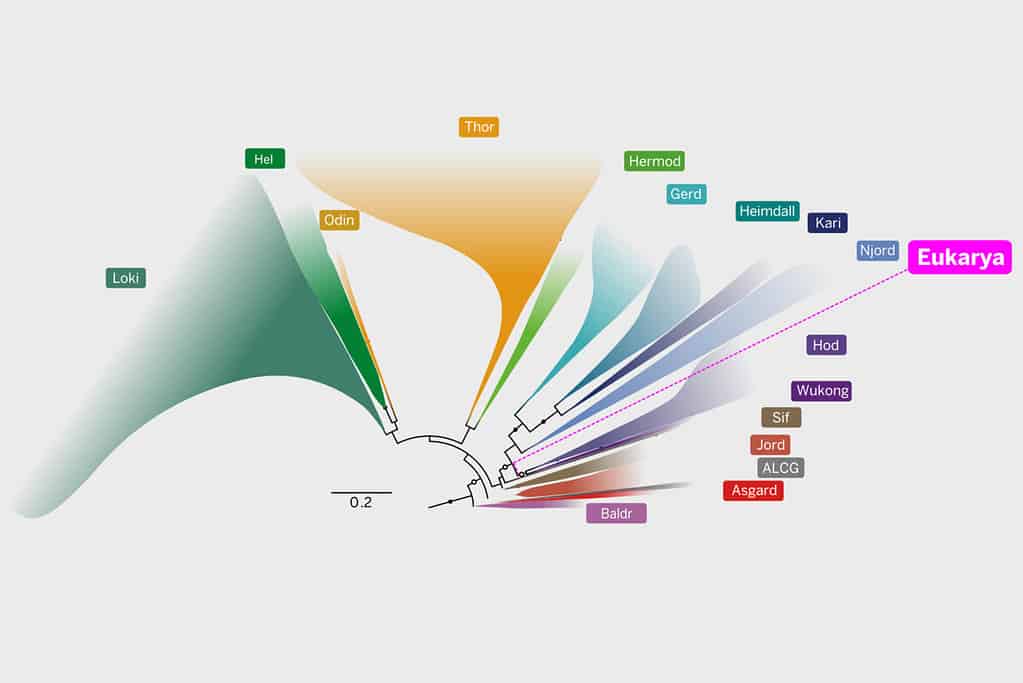
In Norse mythology, Asgard is one of the Nine Worlds, that is inhabited by the Aesir gods, goddesses, and all sorts of mythical creatures. But according to exciting new research, dogs, eagles, starfish, worms, daisies, humans, and virtually all complex life forms are, in a sense, Asgardians. Move over, Thor!
Led by Thijs Ettema of Wageningen University in the Netherlands, the researchers analyzed the genomes of hundreds of archaea microbes. By winding back the molecular clock, the researchers found that all eukaryotes — meaning any organism with a clearly defined nucleus, including all mammals, birds, plants, and so on — can trace their lineage to a common Asgard archaean ancestor.
We are all Asgardians
Asgard archaea, also known as Asgard superphylum, is a group of ancient microorganisms that first appeared two billion years ago. Asgard archaea were discovered relatively recently, and their significance lies in their potential to provide insight into the early evolution of eukaryotic cells.
In 2010, researchers analyzed sediment samples from a gravity core extracted in the Arctic Ocean’s Knipovich ridge, close to the Loki’s Castle hydrothermal vent site. Certain sediment layers, previously identified for their high abundance of novel archaeal lineages, underwent metagenomic analysis.
In 2015, researchers at Uppsala University performed metagenome analysis on sediment layers, discovering new phylum known as Lokiarchaeota. The phylum was named after the shape-shifting Norse god Loki, alluding to the hydrothermal vent complex where the initial genome sample originated.
In 2016, researchers from the University of Texas discovered another group of archaea called Thorarchaeota, derived from samples obtained from North Carolina’s White Oak River. This naming convention was inspired by the Norse god Thor.
Subsequent sampling efforts in various locations, such as Loki’s Castle, Yellowstone National Park, Aarhus Bay, the Colorado River aquifer, New Zealand’s Radiata Pool, and hydrothermal vents near Taketomi Island in Japan, revealed the existence of additional groups named Odinarchaeota (after Odin) and Heimdallarchaeota (after Heimdallr).
To encompass these diverse microbial groups, scientists coined the term “Asgard” for the superphylum.
Decoding ancient genomes

Scientists have encountered these enigmatic organisms in deep-sea sediment and hot springs across the globe, but only a limited number of strains have been successfully cultivated in laboratory settings. Asgard microbes are extremely finicky. They can’t be centrifuged, stirred, exposed to oxygen, separated from other microbes, or rushed into growing any faster than a glacial pace.
Nevertheless, a handful of researchers believe it’s still worth working with these stubborn bacteria. There are no fossil traces of eukaryotes older than two billion years, which is why evolutionary biologists strongly believe that Asgard archaea may have preceded them. Every other creature built from eukaryotic cells could be mere offshoots of the Asgard group.
To gain insight into their genetic blueprints, Thijs’s team extracted genetic material from the environment and meticulously assembled their genomes. This data was then compared and contrasted with genomic data from similar microbes that can be grown without difficulty in the lab.
This way, they could infer the metabolism and other features of the Asgards. It’s a lot like a time machine that scientists can use to reconstruct the past of some of the earliest life forms ever.
Within the vast realm of Asgard archaea, scientists have uncovered the closest microbial relative to all complex life forms — a newly described order called the Hodarchaeales, or Hods for short.
The genomic data suggests that the common ancestor of all modern Asgards thrived in hot environments, utilizing CO2 and chemicals for sustenance. Meanwhile, Hods, which are closely related to eukaryotes, display metabolic similarities to complex organisms like ourselves. They exhibit a preference for cooler environments and rely on carbon consumption for survival.
“So, what events led microbes to evolve into eukaryotes?” said Brett Baker, a University of Texas at Austin associate professor of integrative biology and marine science. “That’s a big question. Having this common ancestor is a big step in understanding that.”
This research marks an exciting milestone in our quest to comprehend the origins of eukaryotic cells. By examining the molecular blueprints of the Asgardian ancestor, scientists gain unprecedented glimpses into the intricate processes that set the stage for the evolution of complex life forms.
The findings appeared in the journal Nature.






